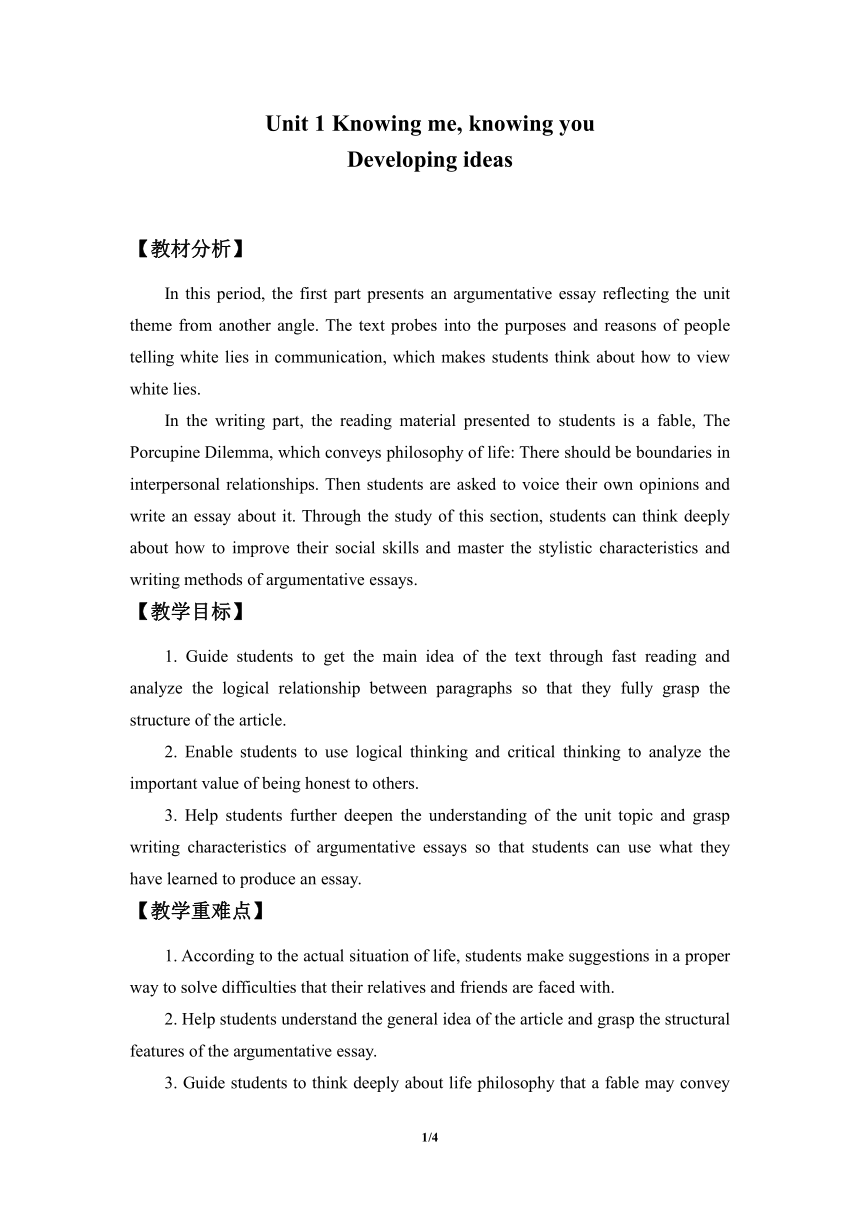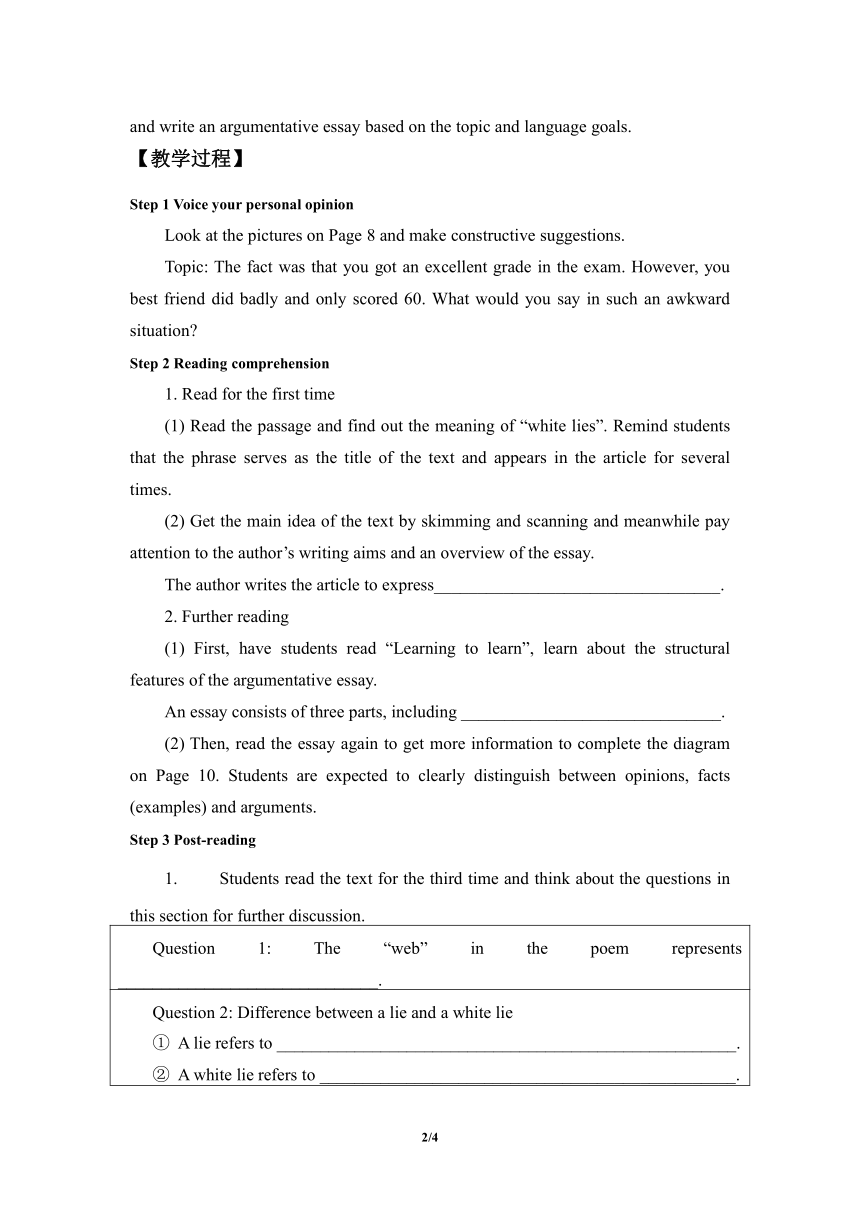外研版(2019)必修第三册Unit 1 Knowing me,Knowing youDeveloping ideas教案
文档属性
| 名称 | 外研版(2019)必修第三册Unit 1 Knowing me,Knowing youDeveloping ideas教案 |  | |
| 格式 | zip | ||
| 文件大小 | 20.0KB | ||
| 资源类型 | 教案 | ||
| 版本资源 | 外研版(2019) | ||
| 科目 | 英语 | ||
| 更新时间 | 2022-08-22 20:55:05 | ||
图片预览


文档简介
Unit 1 Knowing me, knowing you
Developing ideas
【教材分析】
In this period, the first part presents an argumentative essay reflecting the unit theme from another angle. The text probes into the purposes and reasons of people telling white lies in communication, which makes students think about how to view white lies.
In the writing part, the reading material presented to students is a fable, The Porcupine Dilemma, which conveys philosophy of life: There should be boundaries in interpersonal relationships. Then students are asked to voice their own opinions and write an essay about it. Through the study of this section, students can think deeply about how to improve their social skills and master the stylistic characteristics and writing methods of argumentative essays.
【教学目标】
1. Guide students to get the main idea of the text through fast reading and analyze the logical relationship between paragraphs so that they fully grasp the structure of the article.
2. Enable students to use logical thinking and critical thinking to analyze the important value of being honest to others.
3. Help students further deepen the understanding of the unit topic and grasp writing characteristics of argumentative essays so that students can use what they have learned to produce an essay.
【教学重难点】
1. According to the actual situation of life, students make suggestions in a proper way to solve difficulties that their relatives and friends are faced with.
2. Help students understand the general idea of the article and grasp the structural features of the argumentative essay.
3. Guide students to think deeply about life philosophy that a fable may convey and write an argumentative essay based on the topic and language goals.
【教学过程】
Step 1 Voice your personal opinion
Look at the pictures on Page 8 and make constructive suggestions.
Topic: The fact was that you got an excellent grade in the exam. However, you best friend did badly and only scored 60. What would you say in such an awkward situation
Step 2 Reading comprehension
1. Read for the first time
(1) Read the passage and find out the meaning of “white lies”. Remind students that the phrase serves as the title of the text and appears in the article for several times.
(2) Get the main idea of the text by skimming and scanning and meanwhile pay attention to the author’s writing aims and an overview of the essay.
The author writes the article to express_________________________________.
2. Further reading
(1) First, have students read “Learning to learn”, learn about the structural features of the argumentative essay.
An essay consists of three parts, including ______________________________.
(2) Then, read the essay again to get more information to complete the diagram on Page 10. Students are expected to clearly distinguish between opinions, facts (examples) and arguments.
Step 3 Post-reading
1. Students read the text for the third time and think about the questions in this section for further discussion.
Question 1: The “web” in the poem represents ______________________________.
Question 2: Difference between a lie and a white lie ① A lie refers to _____________________________________________________. ② A white lie refers to ________________________________________________.
2. Discuss in groups and then have some students share their experience with the class.
3. If time permits, students are expected to give a talk on the importance of honesty following the steps presented in Activity 4.
Step 4 Before writing
1. Read the writing material and understand the practical significance of the topic.
A. Porcupines are not social animals.
B. The more independent you are, the better your life will be.
C. There should be boundaries in interpersonal relationships.
2. Guide students to analyze the material and summarize life philosophy that a fable conveys.
Step 5 Writing an essay
1. According to the passage in Activity 5, students clarify the logical framework of the essay, including a brief introduction, the main body and a conclusion.
2. Have students discuss the aims and viewpoint of the essay as well as supporting examples. Then complete the notes for Activity 6 with key words.
Introduction Original author: __________________________________________________ Summary of the fable: ______________________________________________
Main body Viewpoint: _______________________________________________________ Supporting examples in your real life: __________________________________ ________________________________________________________________
Conclusion ________________________________________________________________
3. Students independently organize passages according to the logical framework of argumentation.
4. Ask individual students to present their writing to the class. Teacher and other students evaluate the advantages and disadvantages of each composition.
Step 5 Language appreciation
1. Perhaps we comfort ourselves with the knowledge that most of the lies we tell are “white lies”: little lies that we tell to protect others from the truth.
[句式分析]这是一个多重复合句。
(1) that most of the lies we tell are “white lies”是同位语从句(句子成分)解释对其前面名词“knowledge”进行解释说明,该从句中“we tell”是一个定语从句修饰先行词“little lies”。
(2)“that we tell to protect others from the truth”为定语从句修饰先行词“little lies”,而“little lies”又充当“white lies”的同位语(句子成分)。
[尝试翻译]也许我们会这样安慰自己,我们说的大多数谎言都是善意的谎言-即我们为了不让别人知道真相而撒的小谎。
2. One of the main reasons for telling a white lie is to make others feel better.
[句式分析] the reason for sth/ doing sth 意为“……的原因”,to make others feel better不定式短语在句中充当“表语”(句子成分)。
[尝试翻译]说善意谎言的一个主要原因是为了让别人感觉好一些。
3.You of course say that it’s wonderful, despite secretly thinking that your cat can sing better.
[句式分析]despite意为“尽管”,“thinking that your cat can sing better”为现在分词短语充当句子的“状语”(成分),注意动词think与其逻辑主语you构成“主动关系”(语态)。
[尝试翻译]你当然会说这很美妙,尽管你心里认为你的猫唱得更好。
Step 6: Homework
1. Go over the words and expressions learned in this period.
2. Polish your composition and use more advanced vocabulary and complex sentence structures.
4/4
Developing ideas
【教材分析】
In this period, the first part presents an argumentative essay reflecting the unit theme from another angle. The text probes into the purposes and reasons of people telling white lies in communication, which makes students think about how to view white lies.
In the writing part, the reading material presented to students is a fable, The Porcupine Dilemma, which conveys philosophy of life: There should be boundaries in interpersonal relationships. Then students are asked to voice their own opinions and write an essay about it. Through the study of this section, students can think deeply about how to improve their social skills and master the stylistic characteristics and writing methods of argumentative essays.
【教学目标】
1. Guide students to get the main idea of the text through fast reading and analyze the logical relationship between paragraphs so that they fully grasp the structure of the article.
2. Enable students to use logical thinking and critical thinking to analyze the important value of being honest to others.
3. Help students further deepen the understanding of the unit topic and grasp writing characteristics of argumentative essays so that students can use what they have learned to produce an essay.
【教学重难点】
1. According to the actual situation of life, students make suggestions in a proper way to solve difficulties that their relatives and friends are faced with.
2. Help students understand the general idea of the article and grasp the structural features of the argumentative essay.
3. Guide students to think deeply about life philosophy that a fable may convey and write an argumentative essay based on the topic and language goals.
【教学过程】
Step 1 Voice your personal opinion
Look at the pictures on Page 8 and make constructive suggestions.
Topic: The fact was that you got an excellent grade in the exam. However, you best friend did badly and only scored 60. What would you say in such an awkward situation
Step 2 Reading comprehension
1. Read for the first time
(1) Read the passage and find out the meaning of “white lies”. Remind students that the phrase serves as the title of the text and appears in the article for several times.
(2) Get the main idea of the text by skimming and scanning and meanwhile pay attention to the author’s writing aims and an overview of the essay.
The author writes the article to express_________________________________.
2. Further reading
(1) First, have students read “Learning to learn”, learn about the structural features of the argumentative essay.
An essay consists of three parts, including ______________________________.
(2) Then, read the essay again to get more information to complete the diagram on Page 10. Students are expected to clearly distinguish between opinions, facts (examples) and arguments.
Step 3 Post-reading
1. Students read the text for the third time and think about the questions in this section for further discussion.
Question 1: The “web” in the poem represents ______________________________.
Question 2: Difference between a lie and a white lie ① A lie refers to _____________________________________________________. ② A white lie refers to ________________________________________________.
2. Discuss in groups and then have some students share their experience with the class.
3. If time permits, students are expected to give a talk on the importance of honesty following the steps presented in Activity 4.
Step 4 Before writing
1. Read the writing material and understand the practical significance of the topic.
A. Porcupines are not social animals.
B. The more independent you are, the better your life will be.
C. There should be boundaries in interpersonal relationships.
2. Guide students to analyze the material and summarize life philosophy that a fable conveys.
Step 5 Writing an essay
1. According to the passage in Activity 5, students clarify the logical framework of the essay, including a brief introduction, the main body and a conclusion.
2. Have students discuss the aims and viewpoint of the essay as well as supporting examples. Then complete the notes for Activity 6 with key words.
Introduction Original author: __________________________________________________ Summary of the fable: ______________________________________________
Main body Viewpoint: _______________________________________________________ Supporting examples in your real life: __________________________________ ________________________________________________________________
Conclusion ________________________________________________________________
3. Students independently organize passages according to the logical framework of argumentation.
4. Ask individual students to present their writing to the class. Teacher and other students evaluate the advantages and disadvantages of each composition.
Step 5 Language appreciation
1. Perhaps we comfort ourselves with the knowledge that most of the lies we tell are “white lies”: little lies that we tell to protect others from the truth.
[句式分析]这是一个多重复合句。
(1) that most of the lies we tell are “white lies”是同位语从句(句子成分)解释对其前面名词“knowledge”进行解释说明,该从句中“we tell”是一个定语从句修饰先行词“little lies”。
(2)“that we tell to protect others from the truth”为定语从句修饰先行词“little lies”,而“little lies”又充当“white lies”的同位语(句子成分)。
[尝试翻译]也许我们会这样安慰自己,我们说的大多数谎言都是善意的谎言-即我们为了不让别人知道真相而撒的小谎。
2. One of the main reasons for telling a white lie is to make others feel better.
[句式分析] the reason for sth/ doing sth 意为“……的原因”,to make others feel better不定式短语在句中充当“表语”(句子成分)。
[尝试翻译]说善意谎言的一个主要原因是为了让别人感觉好一些。
3.You of course say that it’s wonderful, despite secretly thinking that your cat can sing better.
[句式分析]despite意为“尽管”,“thinking that your cat can sing better”为现在分词短语充当句子的“状语”(成分),注意动词think与其逻辑主语you构成“主动关系”(语态)。
[尝试翻译]你当然会说这很美妙,尽管你心里认为你的猫唱得更好。
Step 6: Homework
1. Go over the words and expressions learned in this period.
2. Polish your composition and use more advanced vocabulary and complex sentence structures.
4/4
